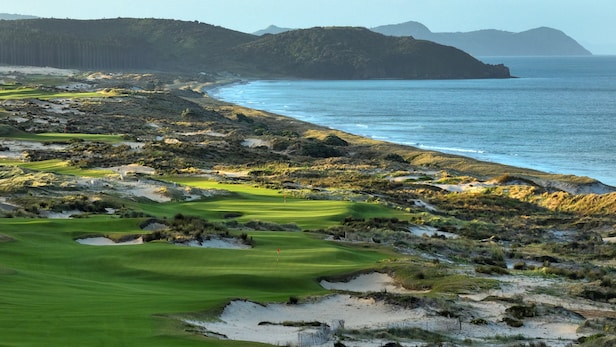


The most important development in golf-course architecture during the past 20 years is the elevation of sand-based sites. Encouraged by the success of destinations like Bandon Dunes, developers have spent this time scouring the globe for sandy, dunes-like properties on which to construct new courses and lure golfers, several of which make their debut on the Golf Digest 2024-2025 World’s 100 Greatest Courses, our ranking of courses outside the United States.
This is nothing new. The first golf courses—the links of Scotland, England, Ireland and Wales—were born from sand. Early golfers forged their way through the gorsed and grassy landscapes of dunes, kettles, eskers and seaside plains, chasing their balls while developing holes, which over time became fully realized courses. Advancements in construction methods throughout the 20th century enabled courses to be built anywhere on any type of land, negating the need for pure natural movements, but sand—near a coast or not—remains the medium that produces golf that most resembles the game as it was conceived.
This year’s ranking reflects a reappraisal of the virtues of sand and, more specifically, links golf. In the 2022-2023 World’s 100 Greatest Courses ranking, 40 courses that could be classified as links were represented (defined here as coastal courses built on mostly sandy linksland). This year that number is 54. This does not count the numerous inland courses built on sand, including those in the Melbourne Sand Belt region, highlighted by Royal Melbourne’s West Course, ranked fifth, or the heathland courses southwest of London, topped by Sunningdale’s Old Course at No. 12.
Just as important as quantity in demonstrating the appreciation for sand is the upward movement of links courses in the rankings. Nine of the top 10 courses are links, up from six in 2022-2023. Links courses, in fact, jumped a collective 351 places in the poll, marked most notably by Trump International surging 33 places, followed by Cruden Bay (30 places), Prestwick (28), Portmarnock (Championship) and Royal Troon (25 each) and Kingsbarns (24). Links stalwarts like Royal Hague (No. 48), designed in 1939 by Charles Alison, Royal St. David’s in Wales (No. 76), Enniscrone in Ireland (No. 87) and Paraparaumu Beach in New Zealand (No. 96) enter or reenter the ranking. “Secondary” courses at established clubs also get love, with Turnberry, Portrush, St. Andrews and several others placing two courses on the list for the first time.
Explore our brand-new course reviews experience with individual course pages for bonus photography, drone footage and expanded reviews of top international courses and all 17,000-plus courses in the United States. Post your own ratings for courses you’ve played … and tell us where it should be ranked.